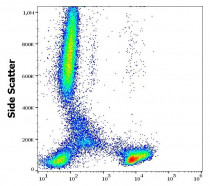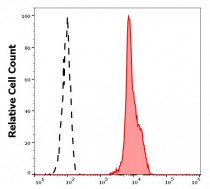ARG53789
anti-CD2 antibody [LT2] (PE)
anti-CD2 antibody [LT2] (PE) for Flow cytometry and Human
Developmental Biology antibody; Immune System antibody
Overview
| Product Description | PE-conjugated Mouse Monoclonal antibody [LT2] recognizes CD2 |
|---|---|
| Tested Reactivity | Hu |
| Tested Application | FACS |
| Specificity | The clone LT2 reacts with CD2, a 50 kDa glycoprotein present on the human peripheral blood T lymphocytes and NK cells; also expressed by all thymocytes. HLDA VI; WS Code T 6T-008 |
| Host | Mouse |
| Clonality | Monoclonal |
| Clone | LT2 |
| Isotype | IgG2b |
| Target Name | CD2 |
| Antigen Species | Human |
| Immunogen | Normal human blood lymphocytes. |
| Conjugation | PE |
| Alternate Names | T-cell surface antigen T11/Leu-5; LFA-3 receptor; T-cell surface antigen CD2; SRBC; Erythrocyte receptor; CD antigen CD2; T11; Rosette receptor; LFA-2 |
Application Instructions
| Application Suggestion |
|
||||
|---|---|---|---|---|---|
| Application Note | * The dilutions indicate recommended starting dilutions and the optimal dilutions or concentrations should be determined by the scientist. |
Properties
| Form | Liquid |
|---|---|
| Purification Note | The purified antibody is conjugated with R-Phycoerythrin (PE) under optimum conditions. The conjugate is purified by size-exclusion chromatography and adjusted for direct use. No reconstitution is necessary. |
| Buffer | PBS, 15 mM Sodium azide and 0.2% (w/v) high-grade protease free BSA |
| Preservative | 15 mM Sodium azide |
| Stabilizer | 0.2% (w/v) high-grade protease free BSA |
| Storage Instruction | Aliquot and store in the dark at 2-8°C. Keep protected from prolonged exposure to light. Avoid repeated freeze/thaw cycles. Suggest spin the vial prior to opening. The antibody solution should be gently mixed before use. |
| Note | For laboratory research only, not for drug, diagnostic or other use. |
Bioinformation
| Database Links | |
|---|---|
| Gene Symbol | CD2 |
| Gene Full Name | CD2 molecule |
| Background | CD2 belongs to T lymphocyte glycoproteins of immunoglobulin superfamily. Its interaction with CD58 stabilizes adhesion between T cells and antigen presenting or target cells. Relatively low affinity of CD2 to CD58 (as measured in solution) is compensated within the two-dimensional cell-cell interface to provide tight adhesion. Moreover, T cell activation induces increased CD2 expression and its lateral mobility, making easier contact between CD2 and CD58. Subsequently, T cell activation causes fixation of CD58-CD2 at sites of cell-cell contact, thereby strengthening intercellular adhesion. CD2 deficiency reduces intestinal inflammation and helps to control infection. |
| Function | CD2 interacts with lymphocyte function-associated antigen (LFA-3) and CD48/BCM1 to mediate adhesion between T-cells and other cell types. CD2 is implicated in the triggering of T-cells, the cytoplasmic domain is implicated in the signaling function. [UniProt] |
| Research Area | Developmental Biology antibody; Immune System antibody |
| Calculated MW | 39 kDa |
Images (2) Click the Picture to Zoom In
-
ARG53789 anti-CD2 antibody [LT2] (PE) FACS image
Flow Cytometry: Human peripheral whole blood stained with ARG53789 anti-CD2 antibody [LT2] (PE) (20 µl reagent / 100 µl of peripheral whole blood).
-
ARG53789 anti-CD2 antibody [LT2] (PE) FACS image
Flow Cytometry: Separation of human CD2 positive lymphocytes (red-filled) from neutrophil granulocytes (black-dashed). Human peripheral whole blood stained with ARG53789 anti-CD2 antibody [LT2] (PE) (20 µl reagent / 100 µl of peripheral whole blood).
Clone References









